Estimation of Soil Moisture Content Based on Fractional Differential and Optimal Spectral Index
Abstract
1. Introduction
2. Materials and Methods
2.1. Research Area and Test Design
2.2. Measurements and Methods
2.2.1. Data Acquisition
2.2.2. Spectral Data Acquisition of Soybean Crown Height
2.2.3. Soil Moisture Content Data Collection
2.3. Spectral Data Processing
2.4. Selection and Construction of Spectral Index
2.5. Model Construction
2.6. Data Processing
- (1)
- Model evaluation index
- (2)
- Significance test
3. Results and Analysis
3.1. Spectral Index Construction and Optimal Spectral Index Band Combination Extraction
3.2. Construction and Comparison of Soil Moisture Content Prediction Model
4. Discussion
5. Conclusions
- (1)
- Compared with the original hyperspectral reflectance data, the correlation between the optimal spectral index of each order extracted after fractional differential transformation and SMC was significantly improved. The average value of the correlation coefficient between each spectral index and SMC under the 1.5-order treatment was 0.380% higher than that of the original spectral index. Among them, mNDI showed the highest correlation, with a correlation coefficient of 0.766.
- (2)
- When the modeling method is the same, and the input variables are different, the accuracy of the SMC prediction model is as follows: 1.5 order > 2.0 order > 1.0 order > 0.5 order > original order. When the input variables are the same and the modeling method changes, the accuracy of the SMC prediction model is as follows: RF > SVM > BPNN. A comprehensive comparison of the model’s evaluation indicators shows that the 1.5-order differential and RF methods are the optimal differential order and optimal model construction methods in this study, respectively. The R2 of the optimal SMC estimation model modeling set and validation set are 0.912 and 0.792, the RMSE is 0.00507 and 0.00393, and the MRE is 2.3901% and 2.3802%.
Author Contributions
Funding
Data Availability Statement
Conflicts of Interest
References
- Wu, F.; Geng, Y.; Zhang, Y.Q.; Ji, C.X.; Chen, Y.F.; Sun, L.; Xie, W.; Ali, T.; Fujita, T. Assessing sustainability of soybean supply in China: Evidence from provincial production and trade data. J. Clean. Prod. 2020, 244, 119006. [Google Scholar] [CrossRef]
- Sfechis, S.; Vidican, R.; Rotar, I.; Stoian, V. Influence of mineral fertilization and zeolite on soybean productivity elements in climatic conditions from ARDS Turda. Bull. Univ. Agric. Sci. Vet. Med. Cluj-Napoca Agric. 2014, 71, 108771. [Google Scholar] [CrossRef] [PubMed]
- Wu, Y.S.; Wang, E.L.; Gong, W.Z.; Xu, L.; Zhao, Z.G.; He, D.; Yang, F.; Wang, X.C.; Yong, T.W.; Liu, J.; et al. Soybean yield variations and the potential of intercropping to increase production in China. Field Crops Res. 2023, 291, 108771. [Google Scholar] [CrossRef]
- Jirayucharoensak, R.; Khuenpet, K.; Jittanit, W.; Sirisansaneeyakul, S. Physical and chemical properties of powder produced from spray drying of inulin component extracted from Jerusalem artichoke tuber powder. Dry. Technol. 2019, 37, 1215–1227. [Google Scholar] [CrossRef]
- Guo, S.; Xu, J. Development Status and Existing Problems of Soybean Food Industry in China. J. Food Sci. Technol. 2023, 41, 1–8. [Google Scholar] [CrossRef]
- Liu, J.; Zhu, L.J.; Zhang, K.; Wang, X.M.; Wang, L.W.; Gao, X.N. Effects of Drought Stress/Rewatering on Photosynthetic Characteristics and Yieldof Soybean at Different Growth Stages. Ecol. Environ. Sci. 2022, 31, 286–296. [Google Scholar] [CrossRef]
- Poudel, S.; Vennam, R.R.; Shrestha, A.; Reddy, K.R.; Wijewardane, N.K.; Reddy, K.N.; Bheemanahalli, R. Resilience of soybean cultivars to drought stress during flowering and early-seed setting stages. Sci. Rep. 2023, 13, 1277. [Google Scholar] [CrossRef]
- Li, S.N.; Zhang, L.; Ma, R.; Yan, M.; Tian, X.J. Improved ET assimilation through incorporating SMAP soil moisture observations using a coupled process model: A study of U.S. arid and semiarid regions. J. Hydrol. 2020, 590, 125402. [Google Scholar] [CrossRef]
- Zhou, Q.W.; Zhu, A.X.; Yan, W.H.; Sun, Z.Y. Impacts of forestland vegetation restoration on soil moisture content in humid karst region: A case study on a limestone slope. Ecol. Eng. 2022, 180, 106648. [Google Scholar] [CrossRef]
- Kelly, B.C.O.; Sivakumar, V. Water Content Determinations for Peat and Other Organic Soils Using the Oven-Drying Method. Dry. Technol. 2014, 32, 631–643. [Google Scholar] [CrossRef]
- Crusiol, L.G.T.; Nanni, M.R.; Furlanetto, R.H.; Sibaldelli, R.N.R.; Sun, L.; Gonçalves, S.L.; Foloni, J.S.S.; Mertz-Henning, L.M.; Nepomuceno, A.L.; Neumaier, N.; et al. Assessing the sensitive spectral bands for soybean water status monitoring and soil moisture prediction using leaf-based hyperspectral reflectance. Agric. Water Manag. 2023, 277, 108089. [Google Scholar] [CrossRef]
- Zai, S.M.; Gao, Y.N.; Wu, F.; Chu, Y.C.; Liu, S.D. Rapid determination of soil moisture based on the principle of spectrophotometry. Water Sav. Irrig. 2021, 1, 1–6. [Google Scholar]
- Cao, Q.; Song, X.D.; Wu, H.Y.; Zhang, G.L.; Yang, S.H. Determination of Basic Parameters of Soil Moisture by Using Ground-Penetrating Radar Ground Wave Method in Red Soil Region of South China. Chin. J. Soil Sci. 2020, 51, 332–342. [Google Scholar]
- Zreda, M.; Shuttleworth, W.J.; Zeng, X.; Zweck, C.; Desilets, D.; Franz, T.; Rosolem, R. COSMOS: The cosmic-ray soil moisture observing system. Hydrol. Earth Syst. Sci. 2012, 16, 4079–4099. [Google Scholar] [CrossRef]
- Medhat, M.E. Application of gamma-ray transmission method for study the properties of cultivated soil. Ann. Nucl. Energy 2012, 40, 53–59. [Google Scholar] [CrossRef]
- Dai, J.J.; Zhang, X.P.; Lv, D.Q.; Luo, Z.D.; He, X.G. Dynamics of Soil Water in Cinnamomum camphora Forest in the Red Soil Hilly Region of South China. Res. Soil Water Conserv. 2019, 26, 123–131. [Google Scholar]
- Yang, C.C.H.; Yang, L.; Zhang, L.; Zhou, C.H. Soil organic matter mapping using INLA-SPDE with remote sensing based soil moisture indices and Fourier transforms decomposed variables. Geoderma 2023, 437, 116571. [Google Scholar] [CrossRef]
- Feng, S.J.; Qiu, J.X.; Crow, W.T.; Mo, X.G.; Liu, S.X.; Wang, S.; Gao, L.; Wang, X.H.; Chen, S. Improved estimation of vegetation water content and its impact on L-band soil moisture retrieval over cropland. J. Hydrol. 2023, 617, 129015. [Google Scholar] [CrossRef]
- Solgi, S.; Ahmadi, S.H.; Seidel, S.J. Remote sensing of canopy water status of the irrigated winter wheat fields and the paired anomaly analyses on the spectral vegetation indices and grain yields. Agric. Water Manag. 2023, 280, 108226. [Google Scholar] [CrossRef]
- Li, W.; Li, D.; Liu, S.Y.; Baret, F.; Ma, Z.Y.; He, C.; Warner, T.A.; Guo, C.L.; Cheng, T.; Zhu, Y.; et al. RSARE: A physically-based vegetation index for estimating wheat green LAI to mitigate the impact of leaf chlorophyll content and residue-soil background. ISPRS J. Photogramm. Remote Sens. 2023, 200, 138–152. [Google Scholar] [CrossRef]
- Wen, P.F.; Meng, Y.; Gao, C.K.; Guan, X.K.; Wang, T.C.; Feng, W. Field Identification of Drought Tolerant Wheat Genotypes Using Canopy Vegetation Indices Instead of Plant Physiological and Biochemical Traits. SSRN Electron. J. 2022, 154, 110781. [Google Scholar] [CrossRef]
- Jahromi, M.N.; Zand-Parsa, S.; Razzaghi, F.; Jamshidi, S.; Didari, S.; Doosthosseini, A.; Pourghasemi, H.R. Developing machine learning models for wheat yield prediction using ground-based data; satellite-based actual evapotranspiration and vegetation indices. Eur. J. Agron. 2023, 146, 126820. [Google Scholar] [CrossRef]
- Gouvêa, D.S.; Marenco, R.A. Is a reduction in stomatal conductance the main strategy of Garcinia brasiliensis (Clusiaceae) to deal with water stress? Theor. Exp. Plant Physiol. 2018, 30, 321–333. [Google Scholar] [CrossRef]
- Sobrino, J.A.; Franch, B.; Mattar, C.; Jiménez-Muñoz, J.C.; Corbari, C. A method to estimate soil moisture from Airborne Hyperspectral Scanner (AHS) and ASTER data: Application to SEN2FLEX and SEN3EXP campaigns. Remote Sens. Environ. 2012, 117, 415–428. [Google Scholar] [CrossRef]
- Panigrahi, N.; Das, B.S. Canopy Spectral Reflectance as a Predictor of Soil Water Potential in Rice. Water Resour. Res. 2018, 54, 2544–2560. [Google Scholar] [CrossRef]
- He, L.; Liu, M.R.; Zhang, S.H.; Guan, H.W.; Wang, C.Y.; Feng, W.; Guo, T.C. Remote estimation of leaf water concentration in winter wheat under different nitrogen treatments and plant growth stages. Precis. Agric. 2023, 24, 986–1013. [Google Scholar] [CrossRef]
- Gutierrez, M.; Reynolds, M.P.; Klatt, A.R. Association of water spectral indices with plant and soil water relations in contrasting wheat genotypes. J. Exp. Bot. 2010, 61, 3291–3303. [Google Scholar] [CrossRef] [PubMed]
- Wei, Y.L.; Li, X.L.; He, Y. Generalisation of tea moisture content models based on VNIR spectra subjected to fractional differential treatment. Biosyst. Eng. 2021, 205, 174–186. [Google Scholar] [CrossRef]
- Leyden, K.; Goodwine, B. Fractional-order system identification for health monitoring. Nonlinear Dyn. 2018, 92, 1317–1334. [Google Scholar] [CrossRef]
- Shiri, B.; Baleanu, D. System of fractional differential algebraic equations with applications. Chaos Soliton Fractals 2019, 120, 203–212. [Google Scholar] [CrossRef]
- Hong, Y.S.; Liu, Y.L.; Chen, Y.Y.; Liu, Y.F.; Yu, L.; Liu, Y.; Cheng, H. Application of fractional-order derivative in the quantitative estimation of soil organic matter content through visible and near-infrared spectroscopy. Geoderma 2019, 337, 758–769. [Google Scholar] [CrossRef]
- Wang, Z.; Zhang, X.; Zhang, F.; Chan, N.W.; Kung, H.; Liu, S.H.; Deng, L.F. Estimation of soil salt content using machine learning techniques based on remote-sensing fractional derivatives; a case study in the Ebinur Lake Wetland National Nature Reserve, Northwest China. Ecol. Indic. 2020, 119, 106869. [Google Scholar] [CrossRef]
- Tang, Z.J.; Guo, J.J.; Xiang, Y.Z.; Lu, X.H.; Wang, Q.; Wang, H.D.; Cheng, M.H.; Wang, H.; Wang, X.; An, J.Q.; et al. Estimation of Leaf Area Index and Above-Ground Biomass of Winter Wheat Based on Optimal Spectral Index. Agronomy 2022, 12, 1729. [Google Scholar] [CrossRef]
- Wijata, A.M.; Foulon, M.-F.; Bobichon, Y.; Vitulli, R.; Celesti, M.; Camarero, R.; Di Cosimo, G.; Gascon, F.; Longépé, N.; Nieke, J.; et al. Taking Artificial Intelligence Into Space Through Objective Selection of Hyperspectral Earth Observation Applications: To bring the “brain” close to the “eyes” of satellite missions. IEEE Geosci. Remote Sens. Mag. 2023, 11, 10–39. [Google Scholar] [CrossRef]
- Sinhal, A.; Verma, B.A. Distribution Based Approach of Outlier Removal for Software Effort Data. Int. J. Comput. Appl. 2013, 74, 24–28. [Google Scholar] [CrossRef]
- Kumar, V.; Sharma, A.; Bhardwaj, R.; Thukral, A.K. Comparison of different reflectance indices for vegetation analysis using Landsat-TM data. Remote Sens. Appl. Soc. Environ. 2018, 12, 70–77. [Google Scholar] [CrossRef]
- Liang, T.G.; Yang, S.X.; Feng, Q.S.; Liu, B.K.; Zhang, R.P.; Huang, X.D.; Xie, H.J. Multi-factor modeling of above-ground biomass in alpine grassland: A case study in the Three-River Headwaters Region. China. Remote Sens. Environ. 2016, 186, 164–172. [Google Scholar] [CrossRef]
- Lao, C.C.; Chen, J.Y.; Zhang, Z.T.; Chen, Y.W.; Ma, Y.; Chen, H.R.; Gu, X.B.; Ning, J.F.; Jin, J.M.; Li, X.W. Predicting the contents of soil salt and major water-soluble ions with fractional-order derivative spectral indices and variable selection. Comput. Electron. Agric. 2021, 182, 106031. [Google Scholar] [CrossRef]
- Bala, M.; Singh, M. Non destructive estimation of total phenol and crude fiber content in intact seeds of rapeseed-mustard using FTNIR. Ind. Crops Prod. 2013, 42, 357–362. [Google Scholar] [CrossRef]
- Wei, Y.; Bao, Y. Nondestructive Detection Method in Soybean Moisture Content Based on BP Neural Network. J. Agr. Mech. Res. 2007, 2, 126–129. [Google Scholar]
- Lin, H.; Liang, L.; Zhang, L.P.; Du, P. Wheat leaf area index inversion with hyperspectral remote sensing based on support vector regression algorithm. Nongye Gongcheng Xuebao/Trans. Chin. Soc. Agric. Eng. 2013, 29, 139–146. [Google Scholar]
- Atteh, E. The Nature of Mathematics Education; The Issue of Learning Theories and Classroom Practice. Asian J. Educ. Soc. Stud. 2020, 10, 42–49. [Google Scholar] [CrossRef]
- Velis, C.A.; Wilson, D.C.; Gavish, Y.; Grimes, S.M.; Whiteman, A. Socio-economic development drives solid waste management performance in cities: A global analysis using machine learning. Sci. Total Environ. 2023, 872, 161913. [Google Scholar] [CrossRef] [PubMed]
- Fang, K.N.; Wu, J.B.; Zhu, J.P.; Bang, C.N. A review of technologies on random forests. J. Stat. Inf. 2011, 26, 32–38. [Google Scholar] [CrossRef]
- Chen, D.S.; Zhang, F.; Tan, M.L.; Chan, N.W.; Shi, J.C.; Liu, C.J.; Wang, W.W. Improved Na+ estimation from hyperspectral data of saline vegetation by machine learning. Comput. Electron. Agric. 2022, 196, 106862. [Google Scholar] [CrossRef]
- Liu, N.; Xing, Z.Z.; Zhao, R.M.; Qiao, L.; Li, M.N.; Liu, G.; Sun, H. Analysis of chlorophyll concentration in potato crop by coupling continuous wavelet transform and spectral variable optimization. Remote Sens. 2020, 12, 2826. [Google Scholar] [CrossRef]
- Song, S.; Song, X.N.; Tejado, B.I. Adaptive projective synchronization for time-delayed fractional-order neural networks with uncertain parameters and its application in secure communications. Trans. Inst. Meas. Control. 2018, 40, 3078–3087. [Google Scholar] [CrossRef]
- Guo, L.; Chen, Y.Y.; Shi, T.Z.; Zhao, C.; Liu, Y.L.; Wang, S.Q.; Zhang, H.T. Exploring the role of the spatial characteristics of visible and near-infrared reflectance in predicting soil organic carbon density. ISPRS Int. J. Geo-Inf. 2017, 6, 308. [Google Scholar] [CrossRef]
- Zhang, Z.P.; Ding, J.L.; Wang, J.Z.; Ge, X.Y. Prediction of soil organic matter in northwestern China using fractional-order derivative spectroscopy and modified normalized difference indices. Catena 2020, 185, 104257. [Google Scholar] [CrossRef]
- Zhang, Z.P.; Ding, J.L.; Zhu, C.M.; Wang, J.Z.; Ma, G.L.; Ge, X.Y.; Li, Z.S.; Han, L.J. Strategies for the efficient estimation of soil organic matter in salt-affected soils through Vis-NIR spectroscopy: Optimal band combination algorithm and spectral degradation. Geoderma 2021, 382, 114729. [Google Scholar] [CrossRef]
- Hong, Y.S.; Guo, L.; Chen, S.C.; Linderman, M.; Mouazen, A.M.; Yu, L.; Chen, Y.Y.; Liu, Y.L.; Liu, Y.F.; Cheng, H.; et al. Exploring the potential of airborne hyperspectral image for estimating topsoil organic carbon: Effects of fractional-order derivative and optimal band combination algorithm. Geoderma 2020, 365, 114228. [Google Scholar] [CrossRef]
- Berger, K.; Verrelst, J.; Féret, J.B.; Wang, Z.H.; Wocher, M.; Strathmann, M.; Danner, M.; Mauser, W.; Hank, T. Crop nitrogen monitoring: Recent progress and principal developments in the context of imaging spectroscopy missions. Remote Sens. Environ. 2020, 242, 111758. [Google Scholar] [CrossRef]
- Norris, C.E.; Quideau, S.A.; Landhäusser, S.M.; Drozdowski, B.; Hogg, K.E.; Oh, S.W. Assessing structural and functional indicators of soil nitrogen availability in reclaimed forest ecosystems using15N-labelled aspen litter. Can. J. Soil Sci. 2018, 98, 357–368. [Google Scholar] [CrossRef]
- Taghizadeh-mehrjardi, R.; Toomanian, N.; Khavaninzadeh, A.R.; Jafari, A.; Triantafilis, J. Predicting and mapping of soil particle-size fractions with adaptive neuro-fuzzy inference and ant colony optimization in central Iran. Eur. J. Soil Sci. 2016, 67, 707–725. [Google Scholar] [CrossRef]
- Li, X.H.; Li, J.G. Comparative Analysis for Grey Relation Estimation Models of Soil Organic Matter based on Hyperspectral Data. IOP Conf. Ser. Earth Environ. Sci. 2021, 820, 012002. [Google Scholar] [CrossRef]
- Lu, J.S.; Eitel, J.U.H.; Engels, M.; Zhu, J.; Ma, Y.; Liao, F.; Zheng, H.B.; Wang, X.; Yao, X.; Cheng, T.; et al. Improving Unmanned Aerial Vehicle (UAV) remote sensing of rice plant potassium accumulation by fusing spectral and textural information. Int. J. Appl. Earth Obs. Geoinf. 2021, 104, 102592. [Google Scholar] [CrossRef]
- Luo, Y.; Lyu, M.-Z.; Chen, J.-B.; Spanos, P.D. Equation governing the probability density evolution of multi-dimensional linear fractional differential systems subject to Gaussian white noise. Theor. Appl. Mech. Lett. 2023, 13, 100436. [Google Scholar] [CrossRef]
- Fu, Z.P.; Jiang, J.; Gao, Y.; Krienke, B.; Wang, M.; Zhong, K.T.; Cao, Q.; Tian, Y.C.; Zhu, Y.; Cao, W.X.; et al. Wheat growth monitoring and yield estimation based on multi-rotor unmanned aerial vehicle. Remote Sens. 2020, 12, 508. [Google Scholar] [CrossRef]
- Eyo, E.U.; Abbey, S.J.; Lawrence, T.T.; Tetteh, F.K. Improved prediction of clay soil expansion using machine learning algorithms and meta-heuristic dichotomous ensemble classifiers. Geosci. Front. 2022, 13, 101296. [Google Scholar] [CrossRef]
- Chen, Y.F.; Hou, F.H.; Dong, S.H.; Guo, L.Y.; Xia, T.Y.; He, G.Y. Reliability evaluation of corroded pipeline under combined loadings based on back propagation neural network method. Ocean Eng. 2022, 262, 111910. [Google Scholar] [CrossRef]
- Dai, Y.M.; Zhao, P. A hybrid load forecasting model based on support vector machine with intelligent methods for feature selection and parameter optimization. Appl. Energy 2020, 279, 115332. [Google Scholar] [CrossRef]
- Croft, H.; Arabian, J.; Chen, J.M.; Shang, J.L.; Liu, J.G. Mapping within-field leaf chlorophyll content in agricultural crops for nitrogen management using Landsat-8 imagery. Precis. Agric. 2020, 21, 856–880. [Google Scholar] [CrossRef]
- Raya-Sereno, M.D.; Ortiz-Monasterio, J.I.; Alonso-Ayuso, M.; Rodrigues, F.A.; Rodríguez, A.A.; González-Perez, L.; Quemada, M. High-resolution airborne hyperspectral imagery for assessing yield; biomass; grain N concentration; and N output in spring wheat. Remote Sens. 2021, 13, 1373. [Google Scholar] [CrossRef]
- Moharana, S.; Dutta, S. Spatial variability of chlorophyll and nitrogen content of rice from hyperspectral imagery. ISPRS J. Photogramm. Remote Sens. 2016, 122, 17–29. [Google Scholar] [CrossRef]
- Wang, C.Y.; Fu, J.X.; Yao, K.; Xue, K.; Xu, K.X.; Pang, X. Acridine-based fluorescence chemosensors for selective sensing of Fe3+ and Ni2+ ions. Spectrochim. Acta-Part A Mol. Biomol. Spectrosc. 2018, 199, 403–411. [Google Scholar] [CrossRef]
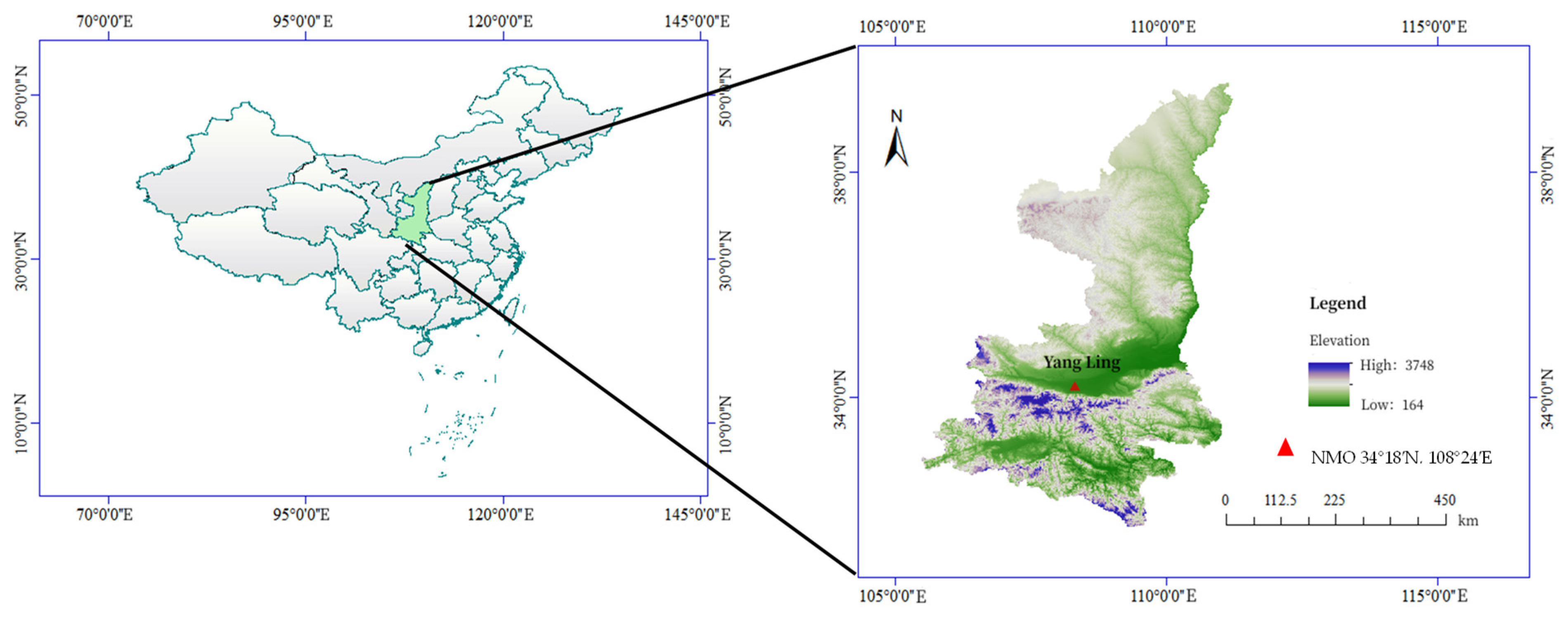
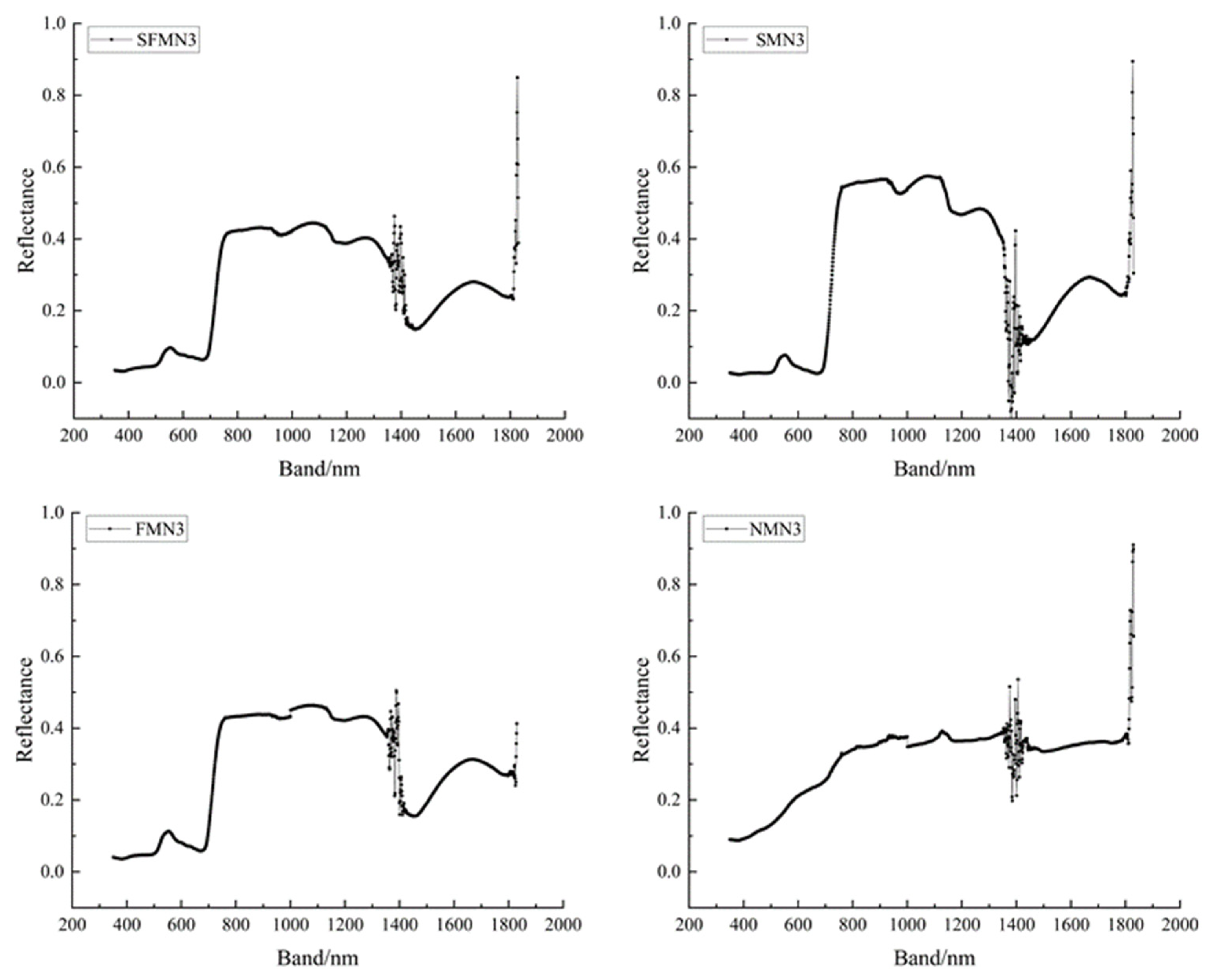
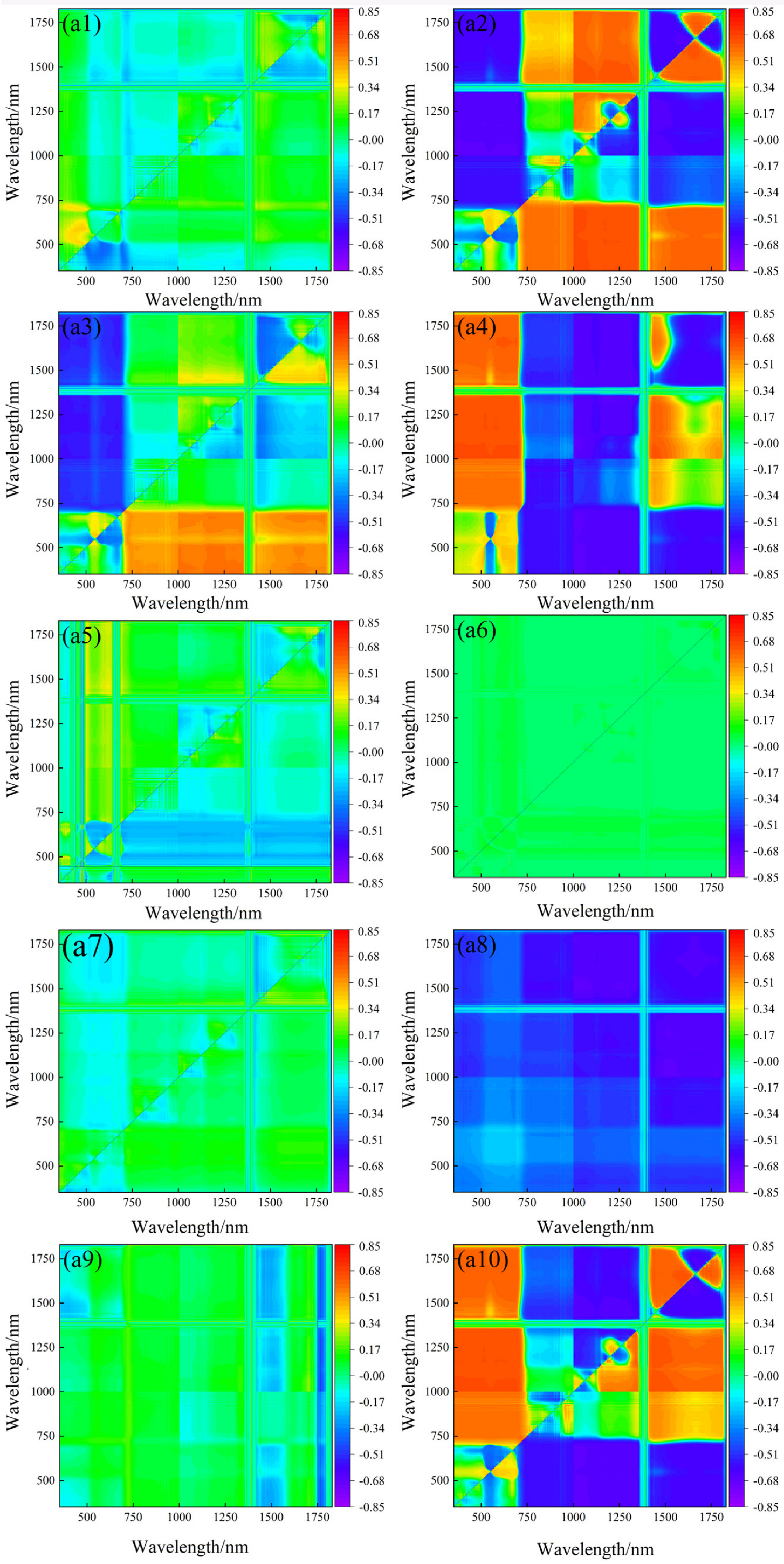
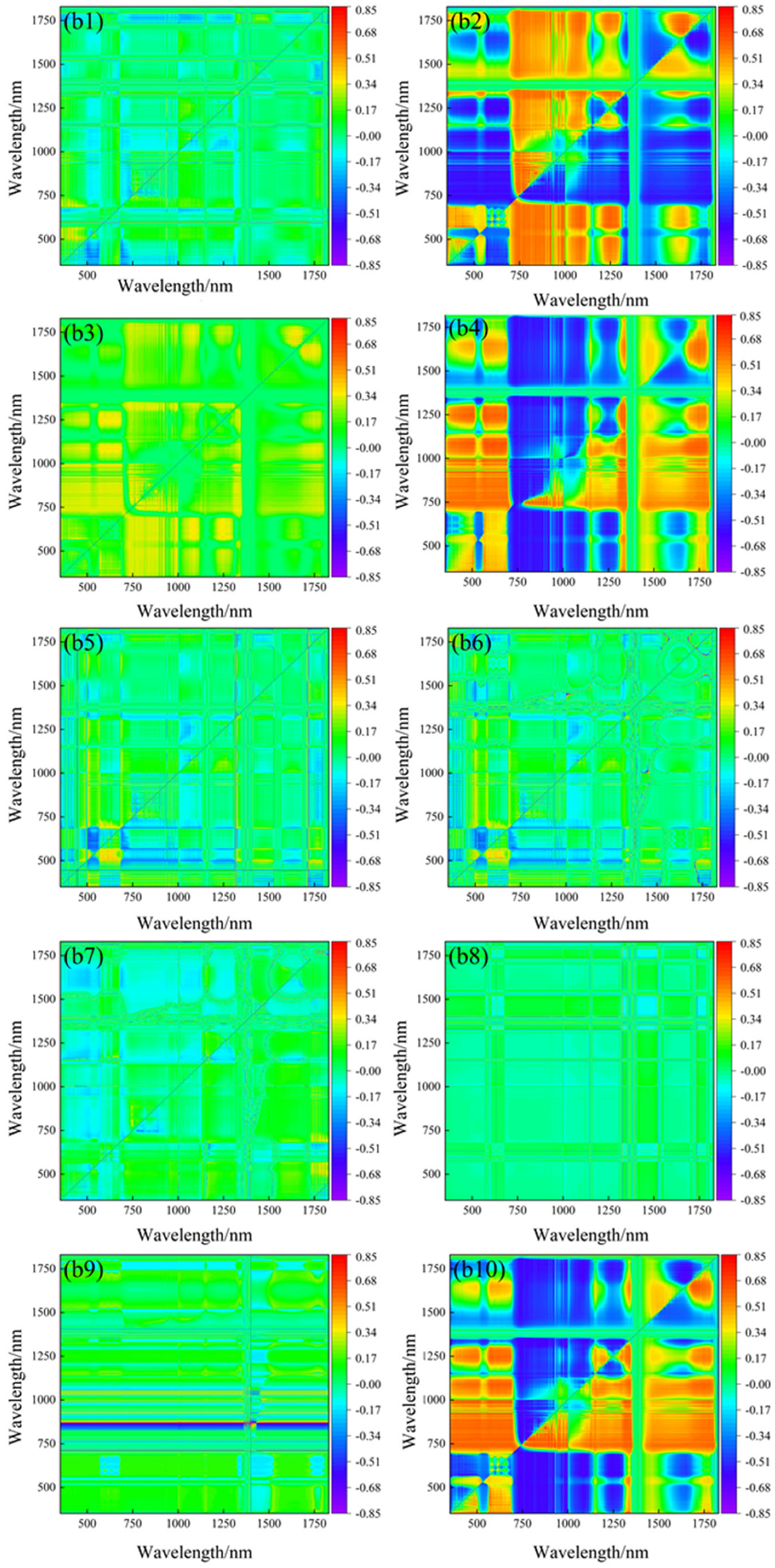

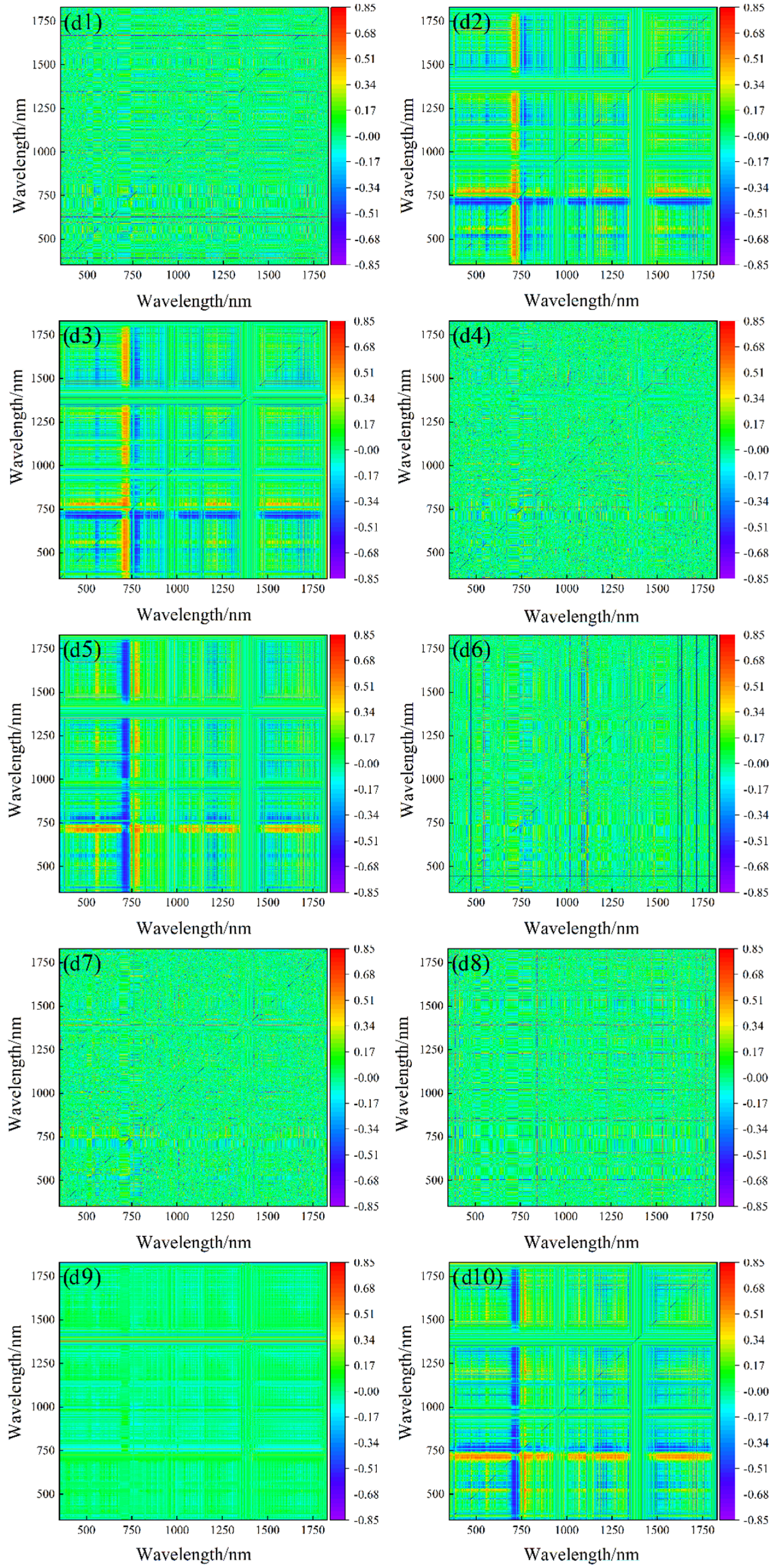
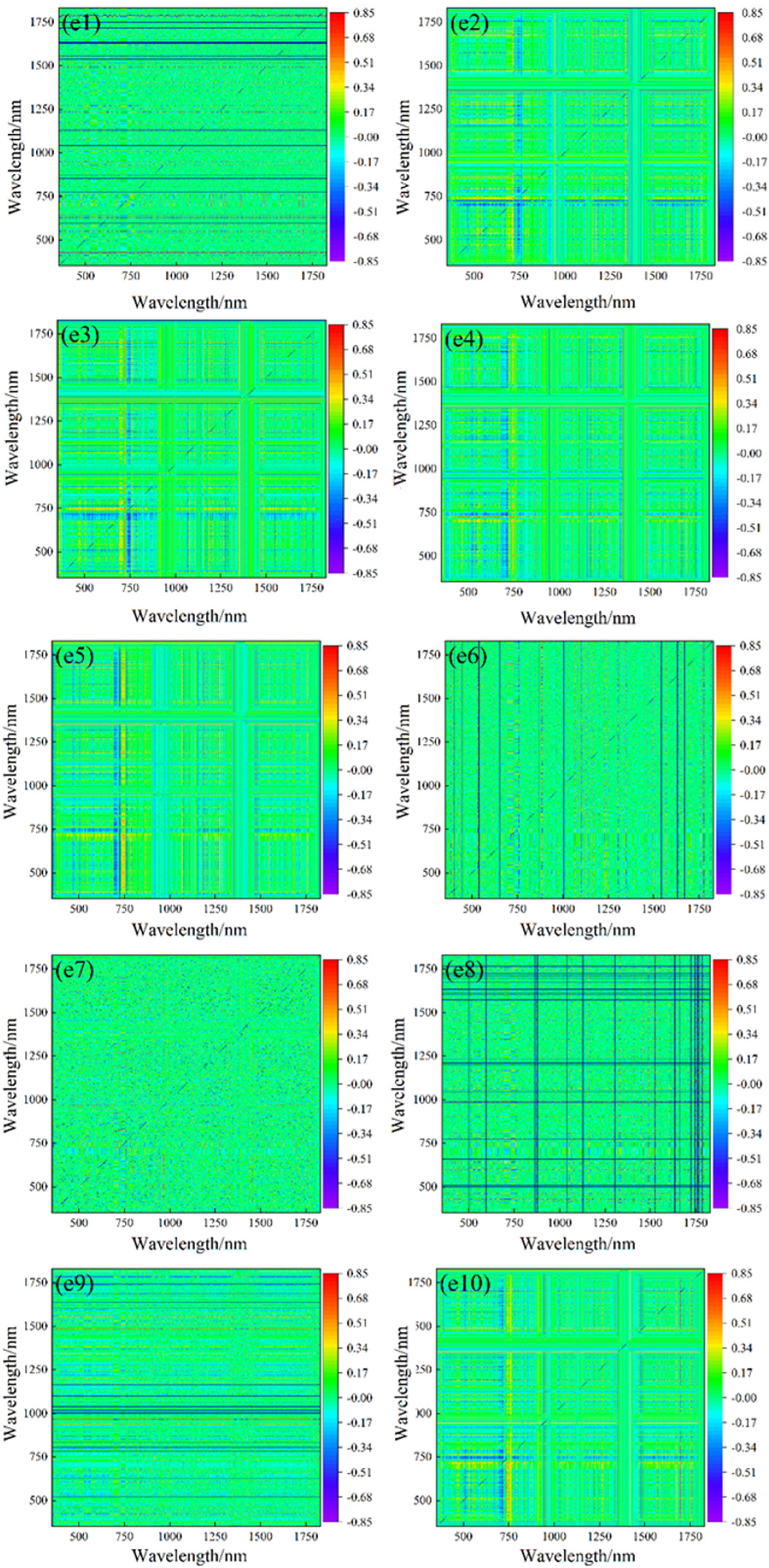

| SFM | NM | SFM | SM | SM | FM |
| N1 | N3 | N2 | N3 | N2 | N1 |
| NM | SFM | SM | FM | FM | NM |
| N1 | N3 | N1 | N3 | N2 | N1 |
| SFM | SFM | SFM | NM | NM | FM |
| N2 | N1 | N3 | N3 | N2 | N3 |
| SM | SM | SM | NM | FM | FM |
| N2 | N1 | N3 | N2 | N2 | N1 |
| Statistical Indicators | Soil Moisture Content |
|---|---|
| Sample Size | 48.00 |
| Maximum Value | 0.16 |
| Minimum Value | 0.11 |
| Mean Value | 0.08 |
| Standard Deviation | 0.01 |
| Coefficient of Variation/% | 12.5 |
| Select Index | Computing Formula | Reference |
|---|---|---|
| RI | [33] | |
| TVI | [33] | |
| DI | [36] | |
| NDVI | [36] | |
| SAVI | [37] | |
| mSR | [35] | |
| mNDI | [35] | |
| TBI-1 | [38] | |
| TBI-2 | [38] | |
| TBI-3 | [38] |
| Differential Order | Spectral Index | Correlation Coefficient | Position of Wavelength (i, j)/(nm) | Optimal Spectral Index Combination |
|---|---|---|---|---|
| 0 | DI | 0.647 ** | 747, 745 | DI, SAVI, TVI, mSR, TBI-3 |
| RI | 0.411 ** | 717, 720 | ||
| NDVI | 0.412 ** | 717, 720 | ||
| SAVI | 0.589 ** | 717, 720 | ||
| TVI | 0.659 ** | 759, 670 | ||
| mSR | 0.619 ** | 719, 718 | ||
| mNDI | 0.447 ** | 719, 718 | ||
| TBI-1 | 0.376 ** | 758, 759 | ||
| TBI-2 | 0.368 ** | 757, 717 | ||
| TBI-3 | 0.711 ** | 747, 745 | ||
| 0.5 | DI | 0.726 ** | 690, 720 | RI, SAVI, TBI-3, mNDI, NDVI |
| RI | 0.651 ** | 737, 748 | ||
| NDVI | 0.698 ** | 745, 737 | ||
| SAVI | 0.731 ** | 748, 737 | ||
| TVI | 0.682 ** | 757, 692 | ||
| mSR | 0.653 ** | 719, 717 | ||
| mNDI | 0.690 ** | 717, 720 | ||
| TBI-1 | 0.648 ** | 720, 753 | ||
| TBI-2 | 0.668 ** | 753, 696 | ||
| TBI-3 | 0.737 ** | 737, 748 | ||
| 1 | DI | 0.719 ** | 731, 721 | DI, NDVI, TBI-3, mNDI, TVI |
| RI | 0.688 ** | 673, 726 | ||
| NDVI | 0.722 ** | 711, 734 | ||
| SAVI | 0.716 ** | 726, 673 | ||
| TVI | 0.722 ** | 737, 696 | ||
| mSR | 0.713 ** | 721, 720 | ||
| mNDI | 0.763 ** | 757, 681 | ||
| TBI-1 | 0.700 ** | 729, 690 | ||
| TBI-2 | 0.628 ** | 700, 724 | ||
| TBI-3 | 0.719 ** | 673, 726 | ||
| 1.5 | DI | 0.721 ** | 726, 700 | mNDI, TVI, TBI-1, NDVI, TBI-3 |
| RI | 0.689 ** | 676, 738 | ||
| NDVI | 0.736 ** | 688, 729 | ||
| SAVI | 0.721 ** | 726, 700 | ||
| TVI | 0.726 ** | 754, 708 | ||
| mSR | 0.721 ** | 692, 726 | ||
| mNDI | 0.766 ** | 740, 696 | ||
| TBI-1 | 0.737 ** | 726, 700 | ||
| TBI-2 | 0.671 ** | 726, 677 | ||
| TBI-3 | 0.722 ** | 726, 700 | ||
| 2 | DI | 0.685 ** | 700, 726 | TVI, NDVI, TBI-1, mSR, mNDI |
| RI | 0.669 ** | 694, 746 | ||
| NDVI | 0.729 ** | 727, 682 | ||
| SAVI | 0.685 ** | 726, 700 | ||
| TVI | 0.703 ** | 723, 714 | ||
| mSR | 0.718 ** | 700, 726 | ||
| mNDI | 0.762 ** | 755, 720 | ||
| TBI-1 | 0.736 ** | 759, 694 | ||
| TBI-2 | 0.698 ** | 675, 676 | ||
| TBI-3 | 0.687 ** | 747, 737 |
| Differential Order | Evaluating Indicator | BPNN | RF | SVM | |||
|---|---|---|---|---|---|---|---|
| Training Sets | Validation Set | Training Sets | Validation Sets | Training Set | Validation Set | ||
| 0 | R2 | 0.629 | 0.652 | 0.714 | 0.722 | 0.642 | 0.679 |
| RMSE (g/kg) | 0.007 | 0.027 | 0.005 | 0.006 | 0.006 | 0.006 | |
| MRE (%) | 4.31 | 4.477 | 3.467 | 4.622 | 3.903 | 4.565 | |
| 0.5 | R2 | 0.652 | 0.693 | 0.838 | 0.725 | 0.678 | 0.695 |
| RMSE (g/kg) | 0.007 | 0.031 | 0.005 | 0.005 | 0.008 | 0.007 | |
| MRE (%) | 3.42 | 11.76 | 3.765 | 3.116 | 4.552 | 4.887 | |
| 1 | R2 | 0.794 | 0.707 | 0.842 | 0.737 | 0.799 | 0.719 |
| RMSE (g/kg) | 0.007 | 0.029 | 0.006 | 0.007 | 0.02 | 0.029 | |
| MRE (%) | 4.428 | 5.471 | 3.164 | 4.831 | 4.444 | 6.4 | |
| 1.5 | R2 | 0.878 | 0.759 | 0.912 | 0.792 | 0.906 | 0.772 |
| RMSE (g/kg) | 0.006 | 0.027 | 0.005 | 0.004 | 0.02 | 0.027 | |
| MRE (%) | 3.674 | 3.176 | 2.891 | 2.780 | 2.988 | 3.974 | |
| 2 | R2 | 0.863 | 0.745 | 0.889 | 0.762 | 0.867 | 0.757 |
| RMSE (g/kg) | 0.02 | 0.007 | 0.006 | 0.004 | 0.02 | 0.026 | |
| MRE (%) | 3.918 | 5.189 | 2.448 | 2.542 | 2.838 | 5.574 | |
Disclaimer/Publisher’s Note: The statements, opinions and data contained in all publications are solely those of the individual author(s) and contributor(s) and not of MDPI and/or the editor(s). MDPI and/or the editor(s) disclaim responsibility for any injury to people or property resulting from any ideas, methods, instructions or products referred to in the content. |
© 2024 by the authors. Licensee MDPI, Basel, Switzerland. This article is an open access article distributed under the terms and conditions of the Creative Commons Attribution (CC BY) license (https://creativecommons.org/licenses/by/4.0/).
Share and Cite
Li, W.; Xiang, Y.; Liu, X.; Tang, Z.; Wang, X.; Huang, X.; Shi, H.; Chen, M.; Duan, Y.; Ma, L.; et al. Estimation of Soil Moisture Content Based on Fractional Differential and Optimal Spectral Index. Agronomy 2024, 14, 184. https://doi.org/10.3390/agronomy14010184
Li W, Xiang Y, Liu X, Tang Z, Wang X, Huang X, Shi H, Chen M, Duan Y, Ma L, et al. Estimation of Soil Moisture Content Based on Fractional Differential and Optimal Spectral Index. Agronomy. 2024; 14(1):184. https://doi.org/10.3390/agronomy14010184
Chicago/Turabian StyleLi, Wangyang, Youzhen Xiang, Xiaochi Liu, Zijun Tang, Xin Wang, Xiangyang Huang, Hongzhao Shi, Mingjie Chen, Yujie Duan, Liaoyuan Ma, and et al. 2024. "Estimation of Soil Moisture Content Based on Fractional Differential and Optimal Spectral Index" Agronomy 14, no. 1: 184. https://doi.org/10.3390/agronomy14010184
APA StyleLi, W., Xiang, Y., Liu, X., Tang, Z., Wang, X., Huang, X., Shi, H., Chen, M., Duan, Y., Ma, L., Wang, S., Zhao, Y., Li, Z., & Zhang, F. (2024). Estimation of Soil Moisture Content Based on Fractional Differential and Optimal Spectral Index. Agronomy, 14(1), 184. https://doi.org/10.3390/agronomy14010184








